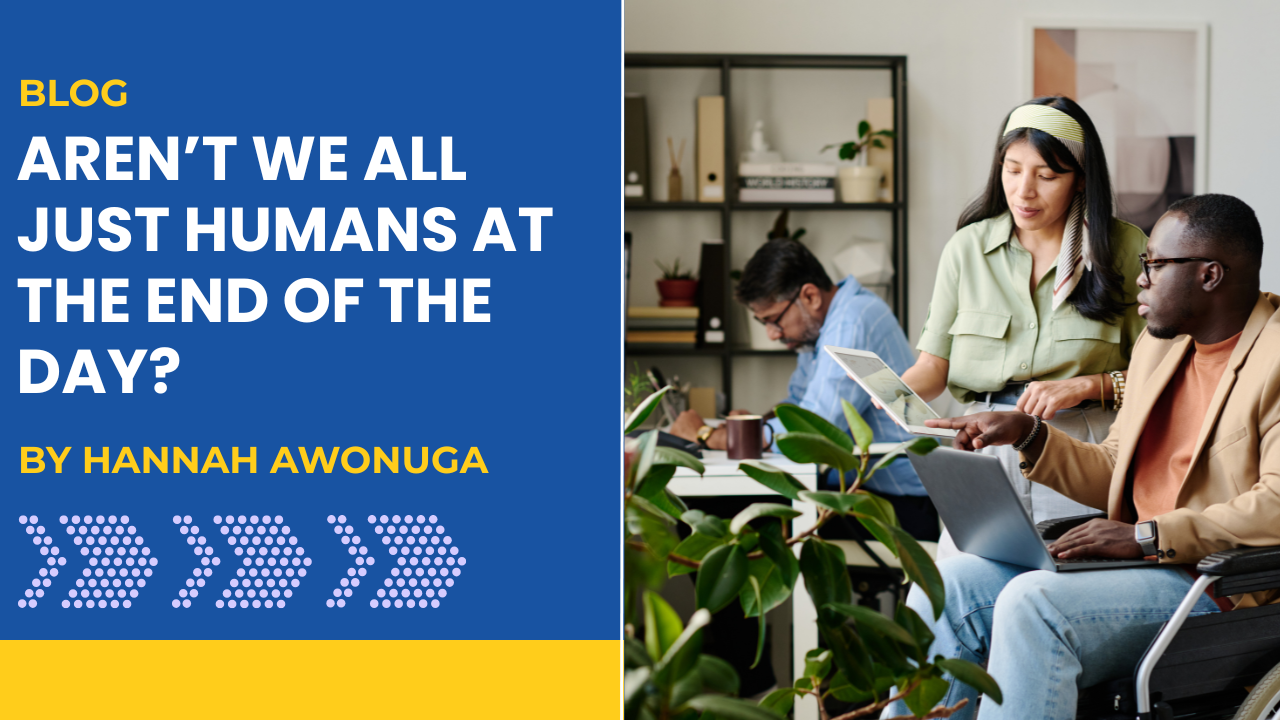Aren’t We All Just Humans At The End Of The Day?
Nov 04, 2025
We are! We are all humans, and, believe it or not, our DNA is 99% identical!!
Every now and then, I hear this phrase in my comments. It’s the most well-intentioned remark we hear in diversity conversations: “Can’t we all just get along?, We are all humans at the end of the day. A sentiment rooted in hope, and often, avoidance.
If only it were that simple.... We are all human, yes, but our experiences and backgrounds differ. Our lives are shaped by race, class, gender, disability, neurodiversity, sexuality, and even our upbringing. We, as humans, are multifaceted, intricate, and nuanced; our differences influence our experiences; they are not barriers to unity, but the fabric of humanity itself.
When we claim to “not see” difference, we are not being neutral; we are erasing context, identity, and truth.
Over the years, I have consciously decided not to accept the phrase 'I don't see colour.' As well-intentioned as it may be, it is harmful and offensive, and it allows people to avoid addressing the systemic barriers and challenges faced by people of colour.
The Illusion of Sameness
I write about this illusion in my upcoming book, 'The Illusion of Inclusion.' Did you know that the scientific truth complicates the idea of race: It does not exist in our DNA,
Race is a social construct.
Biologically, humans are 99.9% the same.
Yet, despite this shared genetic makeup, society has built walls, borders, lines dividing us by colour, postcode, income, accent, and love. We have been told that one race is superior, that where you’re born determines your worth, and that who you love dictates your acceptance.
These divisions are not natural; they’re constructed. And they have real, generational impacts.
A few years ago, I was working with a national police force, and a senior constable said to me, “Hannah, I just treat everyone the same.”
I smiled. It was well-intentioned, heartfelt, and sincere, but it revealed something important. Treating everyone the same isn’t fairness; it’s sameness. And sameness ignores the realities that shape people’s lives, access to safety, trust, and opportunity. When people say “we’re all just human,” it often comes from a good place but it subtly reinforces the illusion that if we stop recognising difference, inequality will disappear.
It’s comforting, but it’s not real.
In reality, our differences shape our access to opportunity, safety, and belonging. When leaders ignore those realities, they risk leading from convenience instead of awareness.
Sameness versus Intentionality
We often hear that equality means treating everyone the same, and that both equality and equity are used interchangeably. They are not the same thing. Equality gives everyone the same resources, while equity recognises that not everyone starts from the same place and adjusts support to create fair outcomes with purpose.
Treating everyone the same assumes sameness, yet we are layered humans with multifaceted identities. What benefits one person might unintentionally disadvantage another. True fairness comes from recognising those differences and responding with care, flexibility, and purpose.
You, as a white man, might need support with communication and empathy, while an Indian woman might be good at communication but need help with confidence... Equity is about giving everyone what they need to thrive; equality is giving both parties the same support!
I’ll let you both decide which is better....
Seeing everyone as “just human” might feel inclusive, but it creates a sameness that can silence the very people inclusion aims to elevate.
What Human-Centric Leadership Really Means
I’ve enjoyed exploring human-centric leadership as part of my methodology for The Inclusive Foundations Programme. I truly believe we need to return to the basics of leadership, focusing on developing great humans who drive performance and results.
Human-centric leadership isn’t about being kind to everyone in the same way; it’s about leading with curiosity, fairness, and courage, recognising the human and celebrating difference and individuality. It understands that each person’s starting point, story, and sense of belonging vary and that equity requires more than intentional action and empathy.
To be human-centric is to:
• See beyond policy— recognise that lived experience doesn’t fit neatly into procedures.
• Be comfortable with discomfort— inclusion work asks us to examine privilege, bias, and blind spots.
• Listen before leading— seek understanding before offering solutions.
• Personalise equity— adjust systems, expectations, and support so everyone has a fair chance to thrive.
When Humanity Meets Leadership, it unlocks potential and growth
There will be moments when leadership cannot prepare you, personal crises, grief, cultural tensions, societal unrest, and global change. These are the moments when leadership becomes human work.
When a team member is grieving, burnt out, or navigating bias, no handbook can tell you how to respond.
Human-centric leadership calls you to lead with empathy and equity. It means asking, “What do you need?” instead of, “When will you be back?”
So Leaders... Can you?
1. See the full picture. Don’t default to sameness; understand how difference influences experiences of work, access, and belonging.
2. Hold space for complexity. People are more than one identity. Make room for intersectionality in decision-making.
3. Model vulnerability. Share what you’re learning and unlearning. Humanity builds trust.
4. Redefine fairness. Fairness isn’t about treating everyone the same—it’s about giving everyone what they need to succeed.
5. Create environments where people can be whole. Celebrate not just performance, but the person behind it.
This is the work, the hard, uncomfortable work, that is required to truly be inclusive.
So yes, we can all get along. I pray for peace every day, but only if we are brave enough to see each other fully. Because true inclusion isn’t found in sameness; it’s found in the courage to embrace difference.

